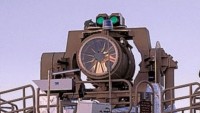US Marines to Arm F-35 Stealth Fighters and SuperCobra Attack Helicopters with Laser Weapons
| Arthur Dominic Villasanta | | Aug 31, 2016 09:17 PM EDT |
(Photo : USMC) U.S. Marines F-35B stealth fighters.
The United States Marine Corps sees combat lasers as its future weapon of choice in attack and defense and plans to mount these weapons on its fleet of combat aircraft and air defense units as soon as posible.
The advantage of combat lasers, also called directed energy weapons, from the Marine Corps' view is they don't require expensive ammunition and can also be used defensively against missiles and other aircraft at a much lower cost, said Lt. Gen. Robert Walsh, Commanding General, Marine Corps Combat Development Command and Deputy Commandant, Combat Development and Integration.
Like Us on Facebook
He said that cost per shot ranges from $300,000 to $400,000 for the AIM-120 Advanced Medium-Range Air-to-Air Missile (AMRAAM) beyond-visual-range missile carried by Marine F-35B stealth fighters. The cost of the 25 millimeter rounds fired by the GAU-22/A four-barreled cannon arming F-35Bs is also expensive .
Gen. Walsh also said the Marines are looking to mount lasers on its fleet of Bell AH-1W SuperCobra attack helicopters and even its Bell Boeing MV-22 Osprey tiltrotor transport and troop carrying aircraft.
"As soon as we could miniaturize them, we would put them on F-35s, Cobra (attack helicopters) ... any of those kind of attack aircraft," said Gen. Walsh.
Lasers will lighten the Marines' logistical requirements, especially in ammunition (which is heavy and dangerous) by reducing the amount of powder and kinetic ordnance Marine units have to lug onto the field, he said.
In addition to its aircraft, the Marines also plan to arm its ground-based air defense units with combat lasers, said Gen. Walsh.
The Marines are working with the Office of Naval Research (ONR) on the Ground-Based Air Defense Directed Energy On-the-Move (GBAD) program, a ground-vehicle mounted high-energy laser system connected to air defense radar systems.
GBAD defends against aerial drones or unmanned aerial vehicles (UAVs). It aims to provide an affordable alternative to traditional firepower to keep enemy UAVs from tracking and targeting Marines on the ground.
Gen. Walsh said ONR has tested a 10 kilowatt laser with the system and "the intent is to move to a 30 kilowatt laser" that can destroy light vehicles.
The Marines' immediate need, however, is to arm its F-35Bs with lasers, said Gen. Walsh. He said mounting a laser on board an F-35 is "absolutely" something the Marines are definitely interested in.
The Marines will start along this road by mounting a laser system on a Lockheed AC-130W Stinger II gunship. Gen. Walsh said this gunship is a better fit for the test because of its huge size, weight and power. He admitted it's been a tough job reducing the size lasers so they can arm smaller aircraft like fighters.
Despite these challenges, Gen. Walsh said laser weapons will be increasingly critical for the Marines in the future.
"It's very important. It's where we want to go," he said.
TagsUnited States Marine Corps, Lasers, Lt. Gen. Robert Walsh, F-35B stealth fighter, Bell AH-1W SuperCobra attack helicopter, MV-22 Osprey
©2015 Chinatopix All rights reserved. Do not reproduce without permission
EDITOR'S PICKS
-

Did the Trump administration just announce plans for a trade war with ‘hostile’ China and Russia?
-

US Senate passes Taiwan travel bill slammed by China
-

As Yan Sihong’s family grieves, here are other Chinese students who went missing abroad. Some have never been found
-

Beijing blasts Western critics who ‘smear China’ with the term sharp power
-

China Envoy Seeks to Defuse Tensions With U.S. as a Trade War Brews
-

Singapore's Deputy PM Provides Bitcoin Vote of Confidence Amid China's Blanket Bans
-

China warns investors over risks in overseas virtual currency trading
-

Chinese government most trustworthy: survey
-

Kashima Antlers On Course For Back-To-Back Titles
MOST POPULAR
LATEST NEWS
Zhou Yongkang: China's Former Security Chief Sentenced to Life in Prison

China's former Chief of the Ministry of Public Security, Zhou Yongkang, has been given a life sentence after he was found guilty of abusing his office, bribery and deliberately ... Full Article
TRENDING STORY

China Pork Prices Expected to Stabilize As The Supplies Recover

Elephone P9000 Smartphone is now on Sale on Amazon India

There's a Big Chance Cliffhangers Won't Still Be Resolved When Grey's Anatomy Season 13 Returns

Supreme Court Ruled on Samsung vs Apple Dispute for Patent Infringement

Microsoft Surface Pro 5 Rumors and Release Date: What is the Latest?













